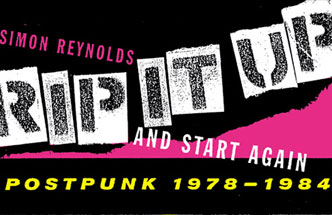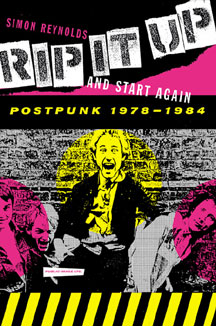Review: Rip It Up and Start Again
27.02.06
 Everything is Post-something it seems, and most artists, writers, and musicians I know make work that’s described as Post-. The Art World is all about Postmodernism, and in Music or Literature, work is often described as Postpunk. From a critical standpoint, there are distinct aesthetic differences between Postmodernism and Postpunk, but for me, the line blurs when hybrid Post- terms crop up, such as Postapocalyptic (the blurb from my book), which I would define as a combination of Postmodernism and Postpunk, due to its Postindustrial implications. In other words, regardless of creative genre, the two terms are sometimes mashed together in order to forge a new kind of Post- sensibility, one that has less to do with specific movements from the past, and more to do with contemporary art, music, or writing that references anything radical or revolutionary that happened 20-40 years ago. Post-, then, can translate loosely as cutting edge. I’ve heard the prefix “post-“ used as an adjective in and of itself more than once. “That’s so post-.” Post- what? When post- degenerates to this level, it usually means that the work makes something new of an old topic. But isn’t that the goal of all music, literature and visual art?
Everything is Post-something it seems, and most artists, writers, and musicians I know make work that’s described as Post-. The Art World is all about Postmodernism, and in Music or Literature, work is often described as Postpunk. From a critical standpoint, there are distinct aesthetic differences between Postmodernism and Postpunk, but for me, the line blurs when hybrid Post- terms crop up, such as Postapocalyptic (the blurb from my book), which I would define as a combination of Postmodernism and Postpunk, due to its Postindustrial implications. In other words, regardless of creative genre, the two terms are sometimes mashed together in order to forge a new kind of Post- sensibility, one that has less to do with specific movements from the past, and more to do with contemporary art, music, or writing that references anything radical or revolutionary that happened 20-40 years ago. Post-, then, can translate loosely as cutting edge. I’ve heard the prefix “post-“ used as an adjective in and of itself more than once. “That’s so post-.” Post- what? When post- degenerates to this level, it usually means that the work makes something new of an old topic. But isn’t that the goal of all music, literature and visual art?
To take issue with this in terms of music, if all the bands I grew up with are Postpunk, how can I be Postpunk too? Shouldn’t I be Postpostpunk? Stupid, right. How long can Postpunk exist? I mean, how fucking important were the Sex Pistols? (Not that.) As a critic who has (irresponsibly and hypocritically) described people as Postwhatever, and as an author whose work is apparently Post-, I’ve thought a lot about Post- and wondered when I won’t be Post- anymore. How does one attain that honorary status, Proto-? It’s great to be reviewed at all, but calling someone Post- can also be a cut down, like, why not just call artists my age who worship the 70s derivative? Anyway, every generation looks back to artists its parents’ age because those artists were in the spotlight as the new generation formed an identity.
I haven’t been finding many answers in art magazines. Postmodern can be as non-specific an adjective for art as Postpunk is for music. Instead, I‘ve been looking to the great music journalists, the ones from the Golden Era of music writing (yes, the 70s), when writers knew how to give music a social context, instead of plugging sucky corporate recordings at random. Rolling Stone and Spin should be eliminated. If you want derivative, listen to The White Stripes and The Strokes. Corporate Goth bands? Please kill them. How long am I going to have to resort to carefully flipping through yellowed newsprint pages of vintage Rolling Stone and hunting down pricey copies of Creem on eBay? Arthur, Pitchfork, The Wire, Dusted and Mojo are the real music resources now. I want more music magazines that are non-commercial enough to give music meaning.
 Simon Reynolds to the rescue! His 400-page treatise on the Post- topic, Rip It Up and Start Again: Postpunk 1978-1984 (Viking Penguin), is finally available to the U.S. after its initial release in the U.K.. Reynolds, who remembers a time when “writers made a genuine contribution to the scene of their day by generating new ways of thinking about music,” tenaciously assesses everything that happened as a reaction to the Sex Pistols. He discusses the Leeds art school bands like Delta 5 and Gang of Four, Manchester’s Factory records and Joy Division, the history of Rough Trade and independent labels, Goth and New Romanticism, New Pop and the Synth Bands of the early 80s, and the rise of Madonna and MTV. By giving each Postpunk movement its own chapter in the book—its own chapter in history—Reynolds shows how contemporary Postpunk bands, like Liars and Wolf Eyes, have culled from previous sources while he still commends their originality. The book defines Postpunk obliquely, not through cheesy one-sentence clichés, but by attributing the diversity of the era, ‘78-84, to a set of common goals: dissonance, independence, and a desire to destroy previous assumptions.
Simon Reynolds to the rescue! His 400-page treatise on the Post- topic, Rip It Up and Start Again: Postpunk 1978-1984 (Viking Penguin), is finally available to the U.S. after its initial release in the U.K.. Reynolds, who remembers a time when “writers made a genuine contribution to the scene of their day by generating new ways of thinking about music,” tenaciously assesses everything that happened as a reaction to the Sex Pistols. He discusses the Leeds art school bands like Delta 5 and Gang of Four, Manchester’s Factory records and Joy Division, the history of Rough Trade and independent labels, Goth and New Romanticism, New Pop and the Synth Bands of the early 80s, and the rise of Madonna and MTV. By giving each Postpunk movement its own chapter in the book—its own chapter in history—Reynolds shows how contemporary Postpunk bands, like Liars and Wolf Eyes, have culled from previous sources while he still commends their originality. The book defines Postpunk obliquely, not through cheesy one-sentence clichés, but by attributing the diversity of the era, ‘78-84, to a set of common goals: dissonance, independence, and a desire to destroy previous assumptions.
In the prologue, Reynolds does manage to succinctly define the Postpunk culture as a “whole cadre of catalysts and culture warriors, enablers and ideologues who started labels, managed bands, became innovative producers, published fanzines, ran hipster record stores, promoted gigs, and organized festivals. True, the prosaic work of creating and maintaining an alternative culture lacks the glamour of punk’s public gestures of outrage and cultural terrorism. Destroying is always more dramatic than building. But Postpunk was constructive and forward looking. The very prefix ‘post’ implied faith in a future that punk said didn’t exist.” Most inspirational to me, though, are the passages in which Reynolds points out what music culture is presently lacking, as a way to urge present “culture warriors” to accept the challenge. Learn from your forefathers, dammit. For example, instead of bands having “record collection” identities, in which they rattle off to interviewers 10 zillion obscure bands they’re into as a way to prove their coolness, that bands from the Postpunk-era Reynolds describes typically “referred to their inspirations, of course, but they had so many other things—politics, cinema, art, books—on their minds, too. Some…felt that it was self-indulgent or trivial to talk about music per se…to reinforce the sense that pop wasn’t a segmented category insulated from the rest of reality.” But with each wake-up call comes the reality check. “Perhaps overt resistance,” Reynolds muses at the end of his book, “seems not so much futile as difficult to do convincingly, given that the nineties sensibility of irony and disengagement has yet to relinquish its grip on the culture. How to make politics in pop work without it being preaching to the converted…was one of Postpunk’s primary quandaries. Today, it seems that most bands deal with the problem by avoiding it all together.” Rip It Up is, due to the nature of its subject matter, full of information on leftist political strategies, for those who are interested.
Sometimes I forget that art can make a difference, and this book was a reminder. Reynolds seemed to say, ultimately, that to be called Postpunk (or Neopostpunk, in Reynolds’ words) isn’t a cut down at all. Rather, it’s a sign that you’re finding some way to, once again, make something good—whether it be art, music, or literature—based on the idea that the personal is political.
A fraction of bands and labels covered by the book are:
Sex Pistols, Public Image Limited, Buzzcocks, Fast Records, Factory Records, Desperate Bicycles, The Normal, Rough Trade bands, Pop Group, The Slits, Gang of Four, The Mekons, Delta 5, Pere Ubu, Devo, The Fall, Joy Division, Throbbing Gristle, No Wave bands & CBGB’s, Talking Heads & Brian Eno, Wire, Scritti Politti, The B-52s, The Raincoats, Mayo Thompson/Red Krayola, The Residents, Flipper, 2-Tone & Ska bands, Bow Wow Wow, Adam Ant, ESG, Liquid Liquid, New Order, Sonic Youth, Human League, Siouxsie and the Banshees, Bauhaus, Echo and the Bunnymen, Culture Club, Duran Duran, and goes downhill from there, i.e. Frankie Goes to Hollywood sucks!
PS The Cabaret Voltaire section is too long! They suck too!
See www.simonreynolds.net and Reynold’s blog at www.blissblog.blogspot.com